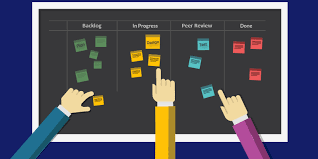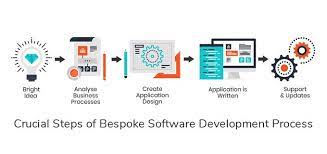The Software Development Life Cycle (SDLC)
The Software Development Life Cycle, or SDLC, is a structured process used by software development teams to create high-quality software efficiently. It consists of a series of well-defined phases that help guide the development team from initial concept to final product delivery and maintenance.
Phases of the SDLC:
- Planning: In this phase, the project scope, requirements, timeline, and budget are defined. This is where the project plan is created and stakeholders are identified.
- Analysis: During this phase, the development team gathers and analyzes requirements from stakeholders. This involves understanding the needs of end-users and creating detailed specifications for the software.
- Design: In this phase, the technical specifications for the software are created. This includes architecture design, database design, user interface design, and more.
- Implementation: The actual coding of the software occurs in this phase. Developers write code based on the design specifications created in the previous phase.
- Testing: Once coding is complete, thorough testing is conducted to identify and fix any bugs or issues in the software. Testing ensures that the software meets all requirements and functions as intended.
- Deployment: The software is deployed to production environments in this phase. Users can now access and use the software in real-world scenarios.
- Maintenance: After deployment, ongoing maintenance is required to ensure that the software continues to function properly. Updates and bug fixes may be released as needed.
Benefits of using SDLC:
- Better Planning: SDLC helps teams plan projects effectively by breaking them down into manageable phases with clear objectives.
- Improved Quality: By following a structured process with testing at each stage, SDLC helps ensure that software meets quality standards.
- Risk Management: Identifying risks early in the process allows teams to mitigate them before they become larger issues later on.
- Cycle Time Reduction: SDLC can help reduce development time by providing a clear roadmap for project completion.
In conclusion, the Software Development Life Cycle is a crucial framework for guiding software development projects from start to finish. By following a structured process like SDLC, development teams can create high-quality software efficiently while meeting stakeholder requirements and expectations.
8 Essential Tips for Mastering the Software Development Life Cycle (SDLC)
- 1. Understand the requirements thoroughly before starting the project.
- 2. Break down the project into smaller tasks for better manageability.
- 3. Use version control to track changes and collaborate effectively.
- 4. Perform regular testing throughout the development process.
- 5. Document each stage of the software development life cycle (SDLC).
- 6. Involve stakeholders at key milestones to gather feedback and ensure alignment.
- 7. Prioritize security measures to protect the software from vulnerabilities.
- 8. Continuously evaluate and improve your SDLC processes for efficiency.
1. Understand the requirements thoroughly before starting the project.
It is essential to thoroughly understand the requirements before initiating a software development project. By taking the time to comprehensively grasp the needs and expectations of stakeholders, developers can ensure that the resulting software aligns with the intended purpose and functionality. Clear and detailed requirements help set a solid foundation for the project, reducing the risk of misunderstandings or costly changes later in the development process. This proactive approach not only streamlines development but also enhances the overall quality and success of the final product.
2. Break down the project into smaller tasks for better manageability.
Breaking down the project into smaller tasks is a key tip in the Software Development Life Cycle (SDLC) process. By dividing the project into manageable chunks, development teams can better organize their work, allocate resources effectively, and track progress more efficiently. This approach not only helps in improving manageability but also allows for easier identification of potential bottlenecks or challenges early on in the project. Additionally, breaking down the project into smaller tasks enables better collaboration among team members and ensures that each task is completed with precision and attention to detail, ultimately leading to a successful and timely project delivery.
3. Use version control to track changes and collaborate effectively.
Utilizing version control is a key tip in the Software Development Life Cycle (SDLC) to track changes and enhance collaboration within development teams. By implementing version control systems such as Git or SVN, developers can easily manage code changes, track revisions, and collaborate seamlessly on projects. Version control allows team members to work on different parts of the codebase simultaneously without the risk of conflicts, ensuring that changes are well-documented and reversible if needed. This practice promotes efficiency, transparency, and accountability throughout the software development process, ultimately leading to higher-quality software products.
4. Perform regular testing throughout the development process.
Tip 4 emphasizes the importance of performing regular testing throughout the software development life cycle (SDLC). By incorporating testing at various stages of development, teams can identify and address potential issues early on, ensuring that the software meets quality standards and functions as intended. Regular testing helps to uncover bugs, errors, and inconsistencies, allowing developers to make necessary adjustments promptly. This proactive approach not only improves the overall quality of the software but also helps in reducing rework and costly fixes later in the development process.
5. Document each stage of the software development life cycle (SDLC).
It is essential to document each stage of the software development life cycle (SDLC) to ensure clarity, consistency, and traceability throughout the project. By documenting each phase, from planning and analysis to design, implementation, testing, deployment, and maintenance, teams can track progress, communicate effectively with stakeholders, and maintain a record of decisions made and actions taken. Comprehensive documentation also serves as a valuable resource for future reference, helping teams learn from past experiences and improve processes for future projects.
6. Involve stakeholders at key milestones to gather feedback and ensure alignment.
To enhance the effectiveness of the Software Development Life Cycle (SDLC), it is essential to involve stakeholders at key milestones throughout the development process. By engaging stakeholders and gathering their feedback, development teams can ensure alignment with project goals and requirements. This collaborative approach not only helps in identifying potential issues early on but also fosters a sense of ownership and transparency among all parties involved. Ultimately, involving stakeholders at key milestones in the SDLC leads to better communication, improved decision-making, and a higher likelihood of delivering a successful software product that meets the needs of all stakeholders.
7. Prioritize security measures to protect the software from vulnerabilities.
In the Software Development Life Cycle (SDLC), it is crucial to prioritize security measures to safeguard the software from vulnerabilities. By focusing on security early in the development process, teams can proactively identify and address potential weaknesses that could be exploited by malicious actors. Implementing robust security measures not only helps protect sensitive data and maintain user trust but also reduces the risk of costly security breaches down the line. Prioritizing security throughout the SDLC ensures that software is built with a strong defense against potential threats, ultimately enhancing its overall reliability and integrity.
8. Continuously evaluate and improve your SDLC processes for efficiency.
It is essential to continuously evaluate and improve your Software Development Life Cycle (SDLC) processes for efficiency. By regularly assessing and refining your SDLC practices, you can identify areas for optimization, streamline workflows, and enhance overall productivity. Implementing feedback mechanisms and conducting thorough reviews allow teams to adapt to changing requirements, technologies, and best practices, ensuring that the SDLC remains effective in delivering high-quality software solutions in a timely manner.




